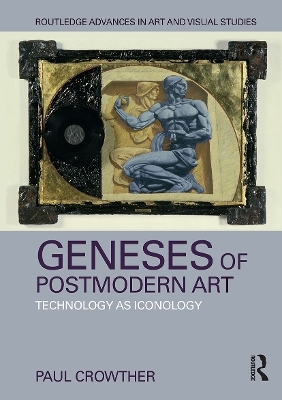
Geneses of Postmodern Art
Technology As Iconology
Seiten
2024
Routledge (Verlag)
978-1-032-92981-1 (ISBN)
Routledge (Verlag)
978-1-032-92981-1 (ISBN)
Postmodernism in the visual arts is not just another 'ism.' To explain why, Paul Crowther investigates topics such as eclecticism, the sublime, deconstruction in art and philosophy, and Paolozzi's Wittgenstein-inspired works.
Postmodernism in the visual arts is not just another 'ism.' It emerged in the 1960s as a transformation of artistic creativity inspired by Duchamp's idea that the artwork does not have to be physically made by its creator. Products of mass culture and technology can be used just as well as traditional media. This idea became influential because of a widespread naturalization of technology - where technology becomes something lived in as well as used. Postmodern art embodies this attitude. To explain why, Paul Crowther investigates topics such as eclecticism, the sublime, deconstruction in art and philosophy, and Paolozzi's Wittgenstein-inspired works.
Postmodernism in the visual arts is not just another 'ism.' It emerged in the 1960s as a transformation of artistic creativity inspired by Duchamp's idea that the artwork does not have to be physically made by its creator. Products of mass culture and technology can be used just as well as traditional media. This idea became influential because of a widespread naturalization of technology - where technology becomes something lived in as well as used. Postmodern art embodies this attitude. To explain why, Paul Crowther investigates topics such as eclecticism, the sublime, deconstruction in art and philosophy, and Paolozzi's Wittgenstein-inspired works.
Paul Crowther is Professor of Philosophy at Alma Mater Europaea – Institutum Studiorum Humanitatis in Slovenia.
Introduction: Technology As Iconology
Chapter 1 – Contingent Objects, Permanent Eclecticism
Chapter 2 - The Eclectic Range of Postmodern Art
Chapter 3 - Space, Power, and Complexity: The Modern and Postmodern Sublimes
Chapter 4 – Deconstruction in Art and Philosophy
Chapter 5 – Subconscious Circuitry: Paolozzi’s Wittgenstein and the Signs of Postmodernism
Chapter 6 – Post-Postmodernism?
| Erscheinungsdatum | 16.10.2024 |
|---|---|
| Reihe/Serie | Routledge Advances in Art and Visual Studies |
| Zusatzinfo | 41 Illustrations, black and white |
| Verlagsort | London |
| Sprache | englisch |
| Maße | 174 x 246 mm |
| Gewicht | 340 g |
| Themenwelt | Kunst / Musik / Theater ► Kunstgeschichte / Kunststile |
| Geisteswissenschaften ► Philosophie | |
| Technik | |
| ISBN-10 | 1-032-92981-2 / 1032929812 |
| ISBN-13 | 978-1-032-92981-1 / 9781032929811 |
| Zustand | Neuware |
| Informationen gemäß Produktsicherheitsverordnung (GPSR) | |
| Haben Sie eine Frage zum Produkt? |
Mehr entdecken
aus dem Bereich
aus dem Bereich


